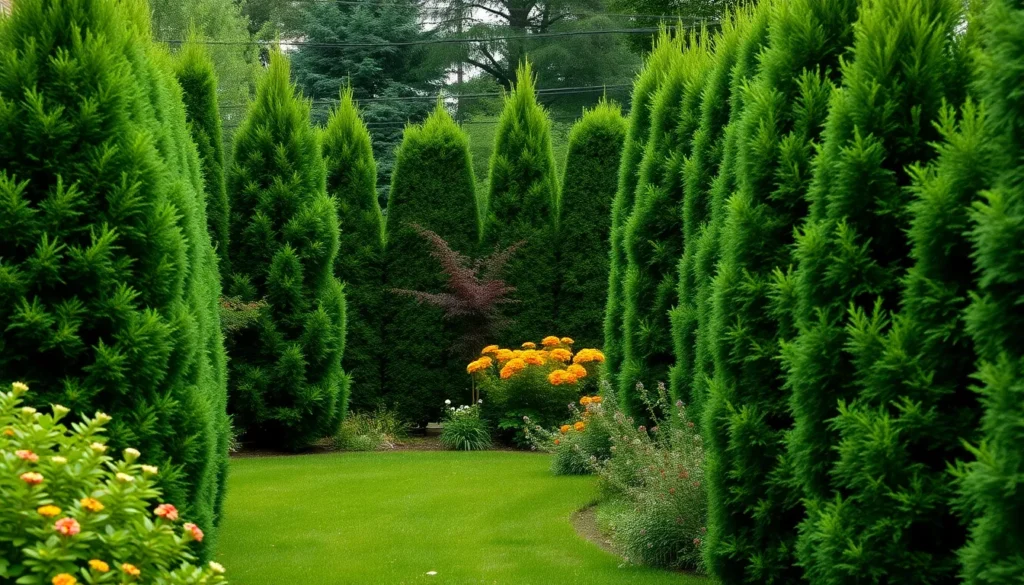Creating a natural privacy barrier around your property doesn’t have to mean installing expensive fencing or unsightly screens. We’ve discovered that strategically planted greenery can transform your outdoor space into a secluded sanctuary while adding beauty and value to your home.
Living privacy fences offer incredible advantages over traditional barriers. They’re cost-effective, environmentally friendly, and provide year-round screening when you choose the right varieties. Plus, they attract beneficial wildlife and can even help reduce noise pollution from busy streets or neighbors.
Whether you’re dealing with nosy neighbors, busy roadways, or simply want to create intimate outdoor spaces, we’ll show you the best plant options that grow quickly and provide dense coverage. From evergreen giants to flowering shrubs, there’s a perfect privacy solution for every climate zone and garden style.
Fast-Growing Evergreen Trees for Instant Privacy
When you need privacy screening that won’t disappear in winter, fast growing evergreen trees deliver the perfect solution for year round coverage.
Leyland Cypress for Year-Round Coverage
Leyland Cypress stands out as one of the fastest growing privacy trees, reaching heights of 3 to 4 feet per year under optimal conditions. These evergreen champions can grow up to 60 feet tall and 15 feet wide, creating an impenetrable green wall that maintains its dense foliage throughout all seasons. We recommend planting them 6 to 8 feet apart for a solid privacy barrier that fills in quickly.
Their tolerance for various soil types makes Leyland Cypress an excellent choice for most residential properties. These trees thrive in USDA hardiness zones 6 through 10, adapting well to both full sun and partial shade conditions. The feathery, blue green foliage provides excellent noise reduction while requiring minimal maintenance once established.
Arborvitae Varieties for Dense Screening
Arborvitae trees offer multiple varieties specifically bred for privacy applications, with growth rates reaching 2 to 3 feet annually. The popular Green Giant variety can reach 50 feet in height while maintaining a narrow 12 foot spread, making it perfect for properties with limited space. Emerald Green Arborvitae provides a more compact option, growing 15 feet tall and 4 feet wide with exceptional cold tolerance.
These evergreen privacy trees feature naturally dense branching that requires little to no pruning to maintain their screening effectiveness. We’ve found that spacing Arborvitae 4 to 6 feet apart creates optimal coverage while allowing proper air circulation. Their pyramid shaped growth pattern and rich green color provide elegant structure to any industry design.
Eastern Red Cedar for Natural Windbreaks
Eastern Red Cedar delivers exceptional durability as a privacy tree while growing 1 to 2 feet per year in challenging conditions where other evergreens struggle. These native trees can reach 40 feet in height with a 15 foot spread, developing naturally dense foliage that provides excellent wind protection and privacy screening. Their remarkable drought tolerance makes them ideal for areas with inconsistent rainfall or water restrictions.
We recommend Eastern Red Cedar for homeowners seeking low maintenance privacy answers that support local wildlife. These trees produce small berries that attract birds while their dense branching provides nesting sites for various species. Plant them 8 to 10 feet apart for windbreak applications or closer together for maximum privacy coverage.
Dense Shrubs That Create Living Walls
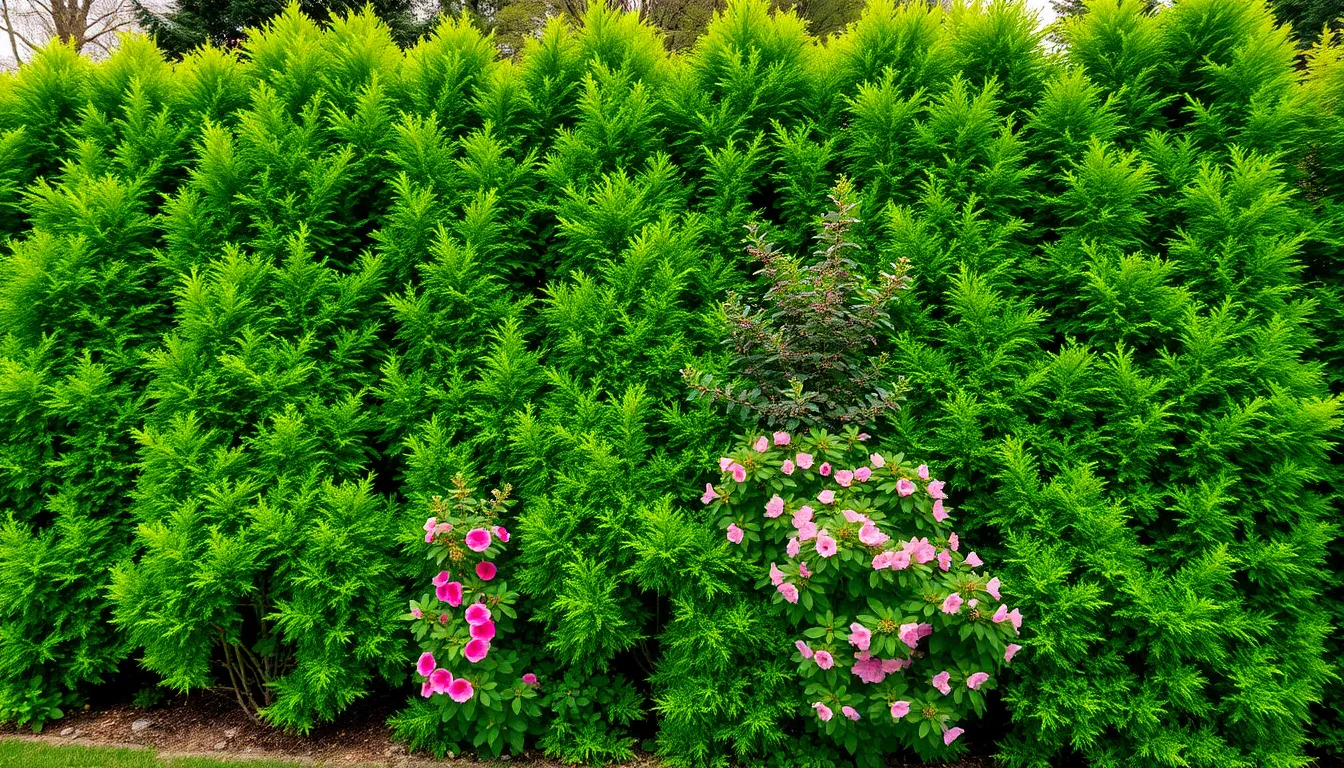
Dense evergreen shrubs create the foundation for impressive living privacy walls that maintain their screening power throughout the year. These versatile plants offer more flexibility than trees while providing substantial coverage for fence lines.
Privet Hedges for Traditional Boundaries
Common Privet and Golden Privet stand out as fast growing champions for creating traditional hedge boundaries. These adaptable shrubs can be pruned into dense, uniform hedges that deliver the classic garden look we associate with established properties. Privet hedges grow quickly and respond well to regular trimming, allowing us to maintain precise shapes and heights.
Seasonal interest comes naturally with privet varieties through their attractive flowers and colorful berries. Golden Privet adds extra visual appeal with its variegated foliage that brightens fence lines year round. Both varieties tolerate various soil conditions and provide reliable screening that looks polished and intentional.
Boxwood for Formal Garden Privacy
Boxwood shrubs deliver unmatched elegance for formal garden settings adjacent to privacy fences. Their dense, glossy evergreen leaves create a sophisticated natural barrier that enhances rather than completely obscures existing fencing. This approach works perfectly when we want privacy without losing the architectural elements of our fence design.
Minimal maintenance makes boxwood an excellent long term investment for privacy plantings. These shrubs thrive in well drained soils and require only occasional pruning to maintain their shape. Boxwood adapts well to both full sun and partial shade conditions, giving us flexibility in placement along different fence orientations.
Viburnum Species for Seasonal Interest
Sweet Viburnum provides dense foliage screening while adding multi seasonal ornamental value to privacy fence lines. These versatile shrubs deliver privacy coverage through their thick growth habit and enhance the space with fragrant spring flowers and colorful fall berries. Viburnum species adapt well to different climate zones, making them reliable choices across various regions.
Mixed border plantings work exceptionally well when we combine viburnums with other evergreen privacy plants. This strategy creates layered screening that maintains year round coverage while providing changing seasonal displays. Viburnums tolerate both sun and partial shade conditions, allowing us to create diverse privacy plantings that look natural and established.
Climbing Vines for Vertical Privacy Solutions
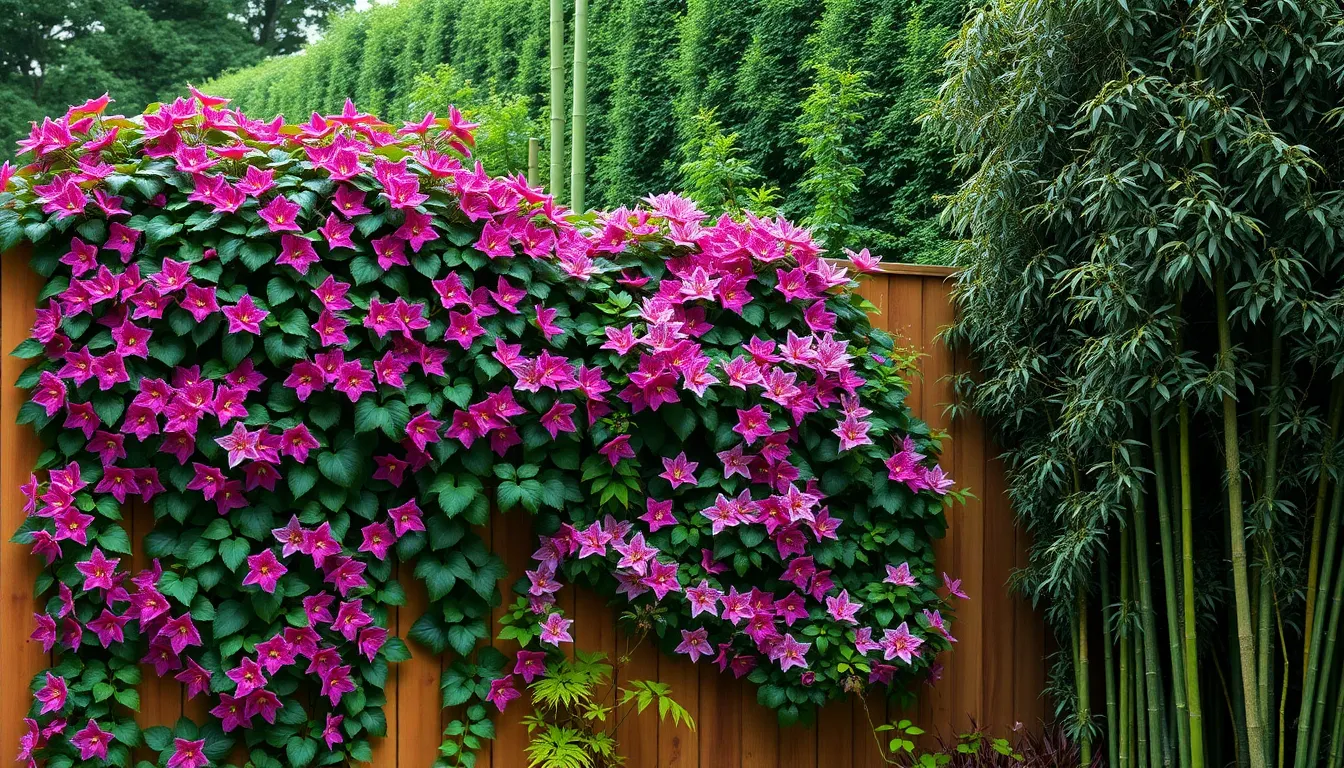
Climbing vines transform bare fences and walls into living privacy screens without consuming valuable ground space. These versatile plants grow vertically, creating dense coverage that shields your property from prying eyes while adding natural beauty to existing structures.
Boston Ivy for Quick Coverage
Boston Ivy delivers rapid coverage for privacy fences with its vigorous climbing growth pattern. This fast-growing vine can reach heights of 30+ feet, making it ideal when you need quick privacy answers for tall barriers. We’ve found that Boston Ivy cloaks fences and walls more efficiently than many other climbing options.
Beyond its impressive coverage speed, Boston Ivy provides stunning seasonal interest that enhances your privacy fence’s aesthetic appeal. The vine’s foliage turns vibrant red in fall, creating a striking visual display that makes your living fence a focal point rather than just a barrier. This dual functionality makes Boston Ivy particularly valuable for homeowners seeking both privacy and industry beauty.
Clematis for Flowering Privacy Screens
Clematis vines combine effective privacy screening with abundant, colorful blooms that brighten your outdoor space. These moderate-growing climbers reach heights of 10-15 feet on trellises or fences, creating flowering privacy barriers that serve multiple purposes. We recommend clematis when you want your privacy fence to double as a garden feature.
Different clematis varieties offer various flower colors and bloom times, allowing you to customize your privacy screen’s appearance throughout the growing season. Some varieties produce flowers in spring, others in summer, and certain types bloom continuously, ensuring your privacy fence remains decorative from early spring through late fall. This versatility makes clematis an excellent choice for creating privacy screens that evolve with the seasons.
Bamboo Varieties for Rapid Growth
Bamboo varieties rank among the fastest-growing plants for privacy fence applications, with some species achieving remarkable vertical growth in just one season. These plants can reach heights of 10-30+ feet, creating tall, dense screens that effectively block both sight lines and noise pollution. We’ve observed that bamboo’s rapid growth makes it particularly appealing for urgent privacy needs.
Clumping bamboo varieties offer controlled growth patterns, making them safer choices for residential privacy applications. Running bamboo types grow faster but require containment systems to prevent unwanted spreading into neighboring areas. Both types form thick hedges that provide excellent year-round privacy screening, though proper variety selection is crucial for long-term success.
The density of bamboo screens makes them exceptionally effective at blocking noise while creating visual privacy barriers. Many homeowners choose bamboo for properties near busy roads or commercial areas because of its superior sound-dampening qualities compared to other privacy plants.
Flowering Plants That Provide Beauty and Seclusion
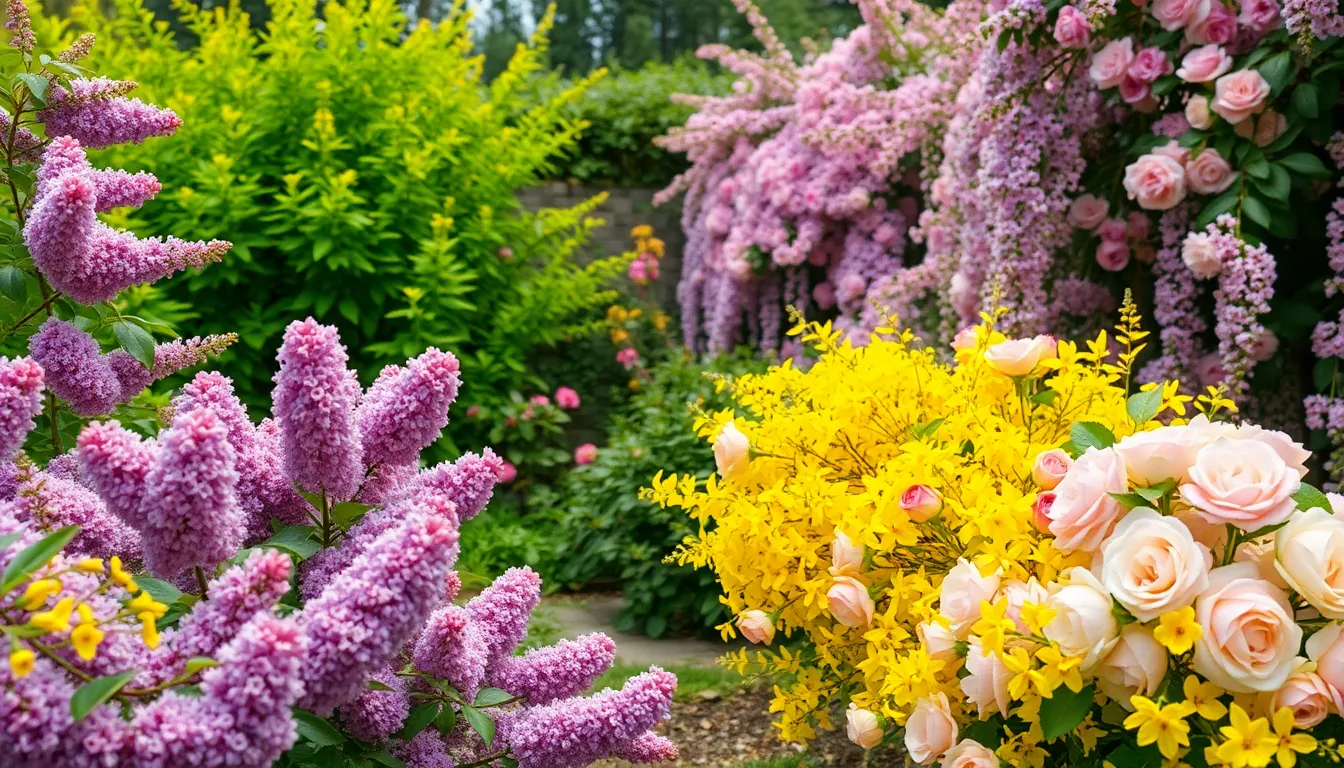
We’ve explored evergreen options and climbing vines for privacy, but flowering plants offer the perfect combination of natural screening and seasonal beauty. These blooming privacy plants create stunning living barriers that change throughout the year while maintaining their screening effectiveness.
Lilac Bushes for Fragrant Privacy
Lilac bushes create some of the most aromatic privacy screens we can plant, growing thick and tall to provide dense coverage. These fragrant bloomers thrive in well-drained soil and full sun, producing abundant spring clusters in purple, white, or pink shades that attract beneficial pollinators to our gardens. Dense foliage blocks sightlines effectively while the intoxicating fragrance adds a sensory dimension that traditional fencing simply can’t match. Growing habits make lilacs excellent for creating secluded garden atmospheres, as their size and density provide year-round screening with spectacular seasonal interest.
Forsythia for Early Spring Color
Forsythia delivers striking yellow flowers before most plants wake up from winter dormancy, creating brilliant early spring displays along our privacy lines. Quick growth reaches heights suitable for effective screening, while arching branches shape easily into dense hedges that block unwanted views. Hardy adaptation allows forsythia to flourish in various soil types with full sun to partial shade conditions. Bright blooms provide aesthetic interest during late winter and early spring when our gardens need color most, making this shrub both functional and visually rewarding for privacy fence applications.
Rose Bushes for Thorny Protection
Rose bushes offer dual-purpose privacy answers by combining natural beauty with built-in security through their thorny stems. Climbing varieties like Rosa banksiae ‘Alba Plena’ work exceptionally well along existing fences, producing cascading fragrant flowers and thick foliage that effectively blocks views while deterring unwanted visitors. Profuse blooming occurs throughout late spring and summer, adding vibrant colors that enhance our outdoor spaces beyond simple screening. Thorny protection makes roses particularly valuable for privacy applications where we want both visual appeal and natural security, creating beautiful barriers that serve multiple functions in our industry design.
Tall Grasses for Modern Privacy Landscaping
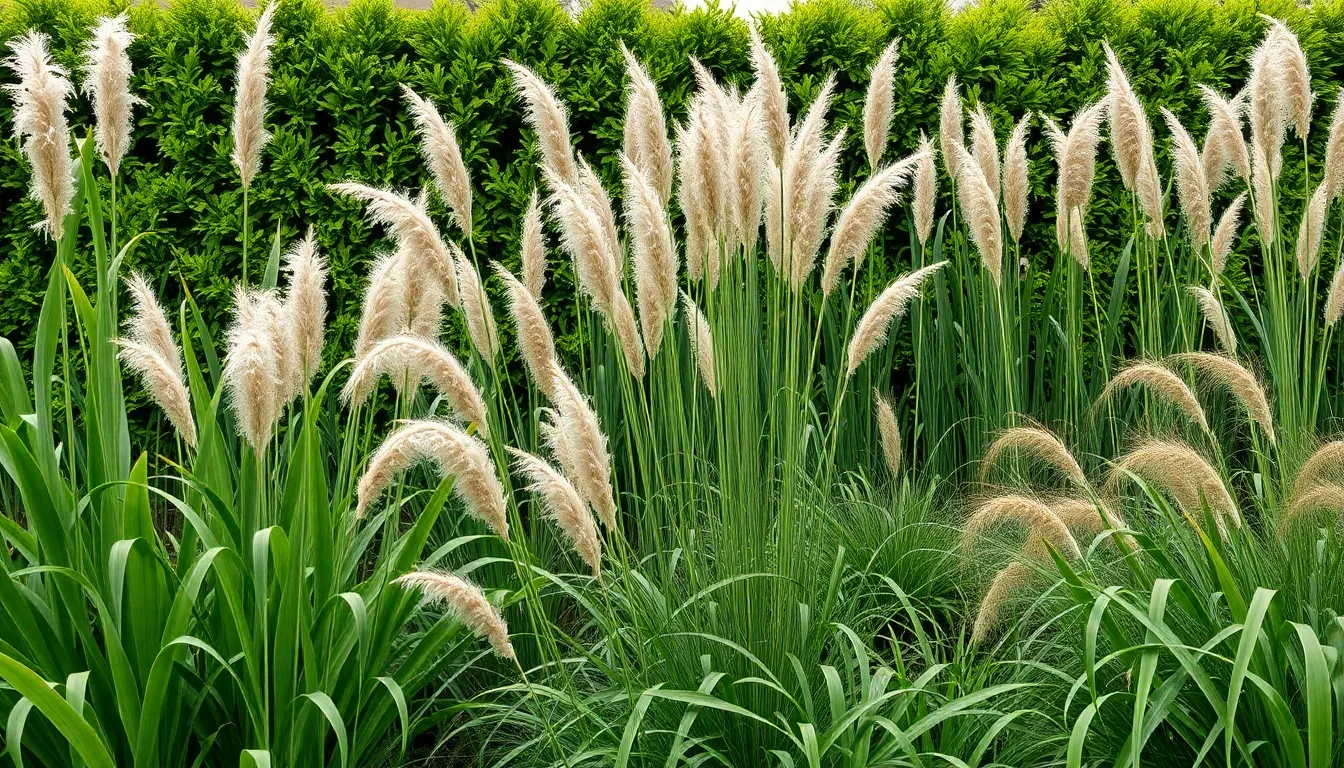
Modern privacy landscaping embraces the natural elegance of tall ornamental grasses that create effective barriers while adding year-round visual interest. These grasses thrive in full sun to partial shade conditions and adapt well to various climates, making them superb choices for natural privacy answers.
Pampas Grass for Dramatic Height
Pampas Grass (Cortaderia selloana) delivers impressive height by growing up to 10 feet tall with large, fluffy plumes that create striking visual elements. Its wide leaves form dense barriers that effectively block unwanted views while serving as industry focal points. We recommend checking local regulations before planting since this grass can be invasive in certain regions. Bold screening capabilities make Pampas Grass particularly valuable for homeowners seeking dramatic privacy answers that make architectural statements.
Fountain Grass for Soft Texture
Fountain Grass (Pennisetum alopecuroides) adds graceful, arching foliage with distinctive bottlebrush-like flower spikes that create softer textures in privacy barriers. Its moderate height works perfectly for supplementing taller grasses or creating layered screening effects. Varying light conditions suit this versatile grass well, allowing it to thrive in different garden locations. Gentle movement from its flowing foliage creates ever-changing visual interest while contributing to effective privacy coverage.
Miscanthus for Four-Season Appeal
Miscanthus species bring year-round interest through upright growth patterns and striking foliage that maintains structure across different seasons. Zebra Grass (Miscanthus sinensis ‘Zebrinus’) and Chinese Silver Grass (‘Gracilimus’) grow 6 to 8 feet tall with attractive plumes that provide both privacy and ornamental value. Distinctive patterns in their foliage create visual focal points that enhance modern landscaping designs. Four-season appeal makes these grasses particularly valuable for homeowners wanting consistent privacy coverage throughout the year.
Low-Maintenance Options for Busy Homeowners
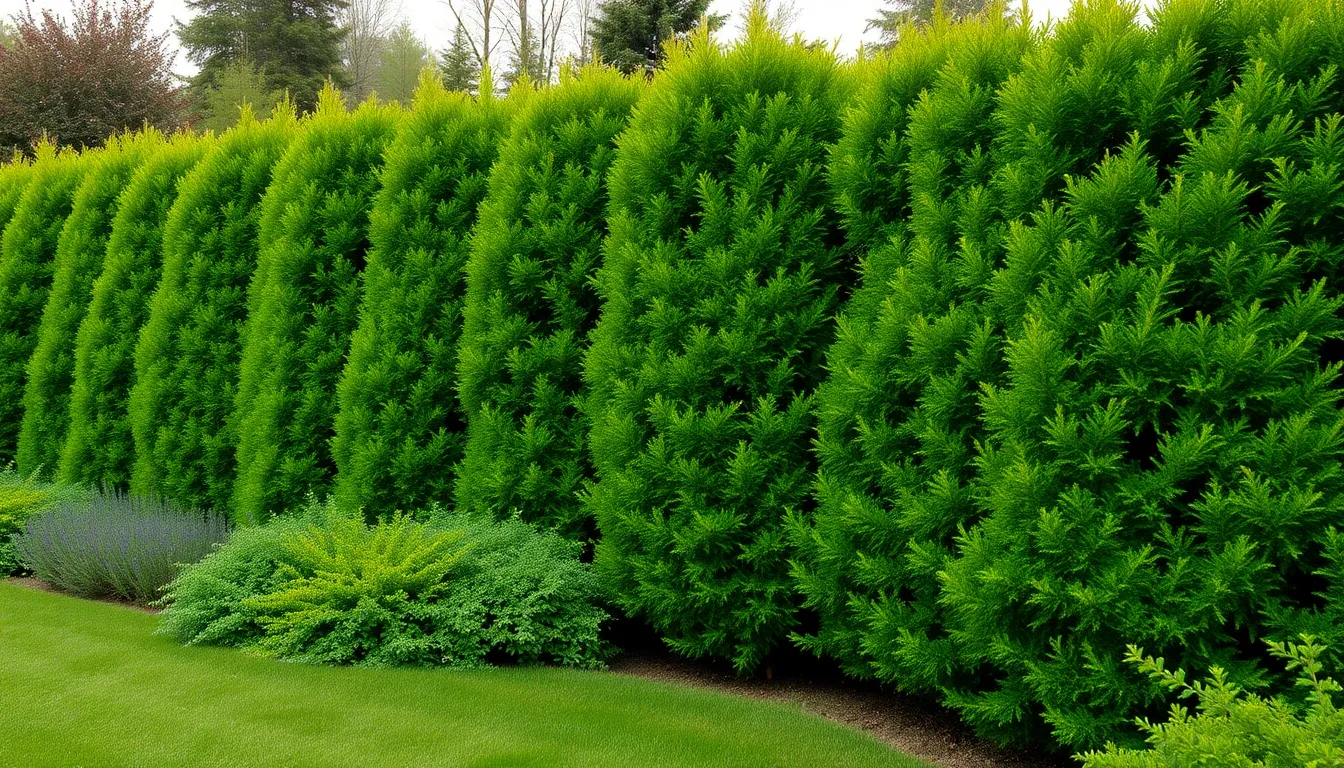
We understand that creating an effective privacy barrier shouldn’t require constant attention. These hardy plant varieties deliver excellent screening results while demanding minimal care from busy homeowners.
Juniper Varieties for Drought Tolerance
Junipers top our list for homeowners dealing with dry conditions or water restrictions. These evergreen champions thrive in drought conditions and need minimal watering once their root systems establish. Dense foliage forms a natural barrier that blocks both unwanted views and noise pollution effectively.
Several juniper species excel in privacy applications while maintaining their low water requirements. Blue Point Juniper reaches 8-12 feet tall with a naturally dense pyramid shape. Spartan Juniper grows faster and taller, making it perfect for larger privacy screens. Both varieties tolerate poor soil conditions and extreme temperatures while maintaining their attractive blue-green coloration year round.
Yew Shrubs for Shade Tolerance
Yews solve the challenge of creating privacy in shaded areas where other evergreens struggle. These tough and hardy shrubs maintain their dense, needle-like evergreen foliage throughout all seasons, ensuring continuous privacy coverage. Hick’s yew varieties work particularly well with their columnar growth pattern, fitting perfectly into both formal hedge layouts and loose natural arrangements.
Maintenance requirements stay minimal with proper initial care. Yews need good drainage, occasional watering during extended drought periods, and annual pruning plus fertilizing for optimal performance. Red berries appear seasonally, adding ornamental interest beyond their privacy function. These adaptable plants tolerate various soil types and handle urban pollution better than many alternatives.
Holly Bushes for Minimal Care Requirements
Holly bushes deliver privacy screening with glossy evergreen leaves that require remarkably little ongoing care. These versatile plants tolerate various soil types and thrive in conditions ranging from partial shade to full sun exposure. Prickly leaves provide an added security benefit beyond visual privacy, deterring unwanted visitors naturally.
Care requirements stay refreshingly simple for busy homeowners. Hollies need only occasional watering during dry spells and light pruning to maintain their desired shape. American Holly and Nellie Stevens Holly varieties work exceptionally well for privacy applications, growing 15-25 feet tall with dense branching patterns. Their adaptability to different growing conditions makes them reliable choices for long term privacy answers that won’t demand constant attention.
Seasonal Considerations for Privacy Plant Selection
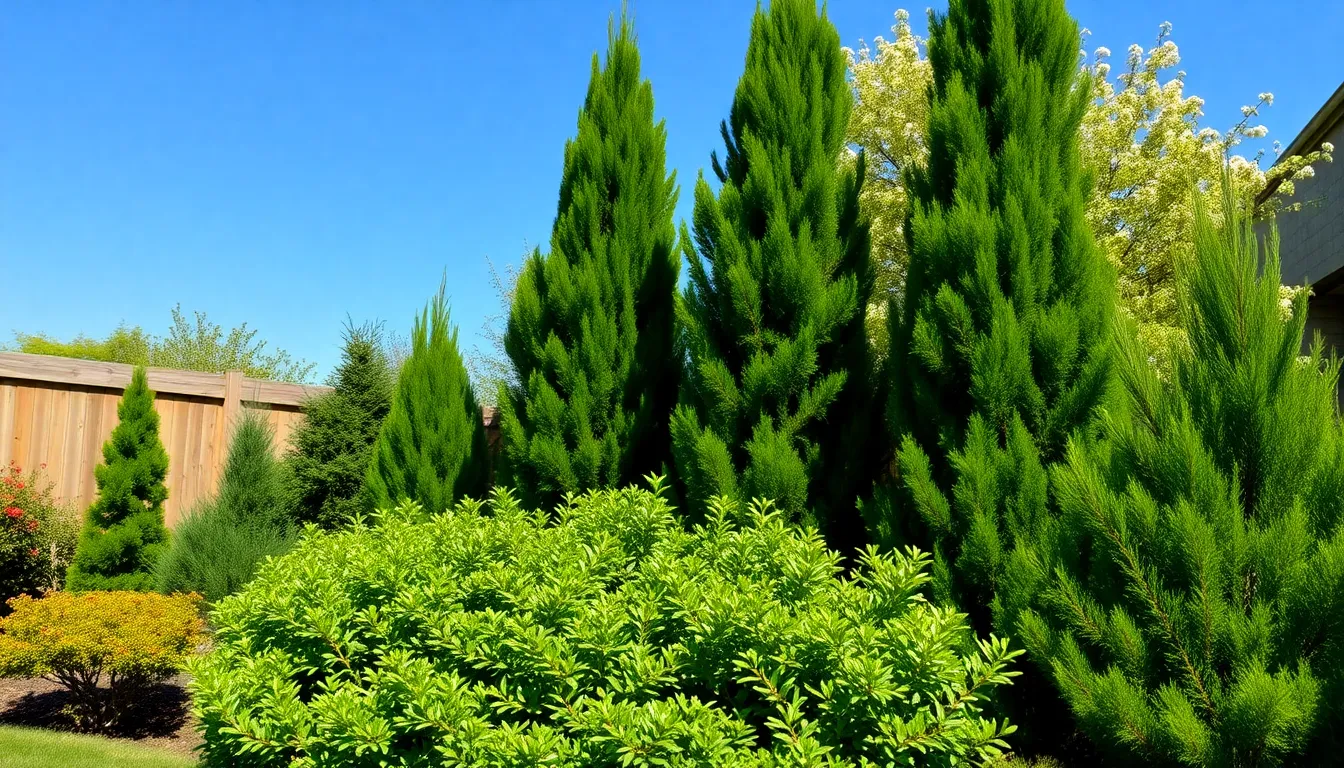
Timing plays a crucial role in establishing successful privacy plantings that thrive for years to come. We’ll explore the optimal seasons for installation and protection strategies to ensure your living fence develops into an effective barrier.
Spring Planting Benefits
Spring offers ideal conditions for privacy plant establishment with moderate temperatures and increased rainfall promoting strong root development. Plants installed during this season have the full growing season ahead to develop and thicken, which speeds up privacy screening effectiveness.
Optimal Growth Conditions:
- Moderate temperatures reduce transplant shock
- Natural rainfall supports root establishment
- Extended growing season allows maximum development
Recommended Spring Plantings:
- Emerald Green Arborvitae thrives when planted in spring, reaching 12’–15′ tall with dense foliage coverage
- Skip Laurel benefits from spring installation, developing its characteristic dark green leaves and fragrant white flowers
- Green Giant Arborvitae establishes quickly in spring conditions, eventually reaching 20’–30′ tall
Fall Installation Advantages
Fall planting allows root systems to develop in cooler soil with adequate moisture before winter dormancy sets in. Plants establish well underground during autumn months and emerge robust in spring, often resulting in less transplant shock compared to spring installations.
Underground Development Benefits:
- Cooler soil temperatures encourage root growth
- Consistent moisture levels support establishment
- Reduced stress from summer heat
Fall Success Stories:
- Leyland Cypress planted in fall develops strong root systems, preparing for rapid 20’–30′ tall growth
- Virescens Western Red Cedar establishes well in fall, supporting its fast growth rate of up to 2 feet per year
Winter Protection Strategies
Evergreen privacy plants need protection from harsh winter winds and cold temperatures, which can cause desiccation and damage. Proper winter care ensures your investment survives and thrives through challenging conditions.
Essential Protection Methods:
| Protection Type | Application | Benefits |
|---|---|---|
| Mulching | Apply 3-4 inches around base | Conserves moisture, insulates roots |
| Burlap Screens | Wrap newly planted specimens | Shields from wind damage |
| Windbreaks | Install temporary barriers | Protects from winter desiccation |
Critical Winter Care:
- Applying mulch around the base conserves moisture and insulates root systems
- Using burlap screens or windbreaks shields plants from winter damage, particularly beneficial for newly planted fall installations
- Monitoring moisture levels prevents winter drought stress in evergreen varieties
Selecting fast growing, dense evergreens and planting at the right time with proper winter care ensures an effective, durable privacy fence using plants that will serve your industry for decades.
Design Tips for Maximum Privacy Impact
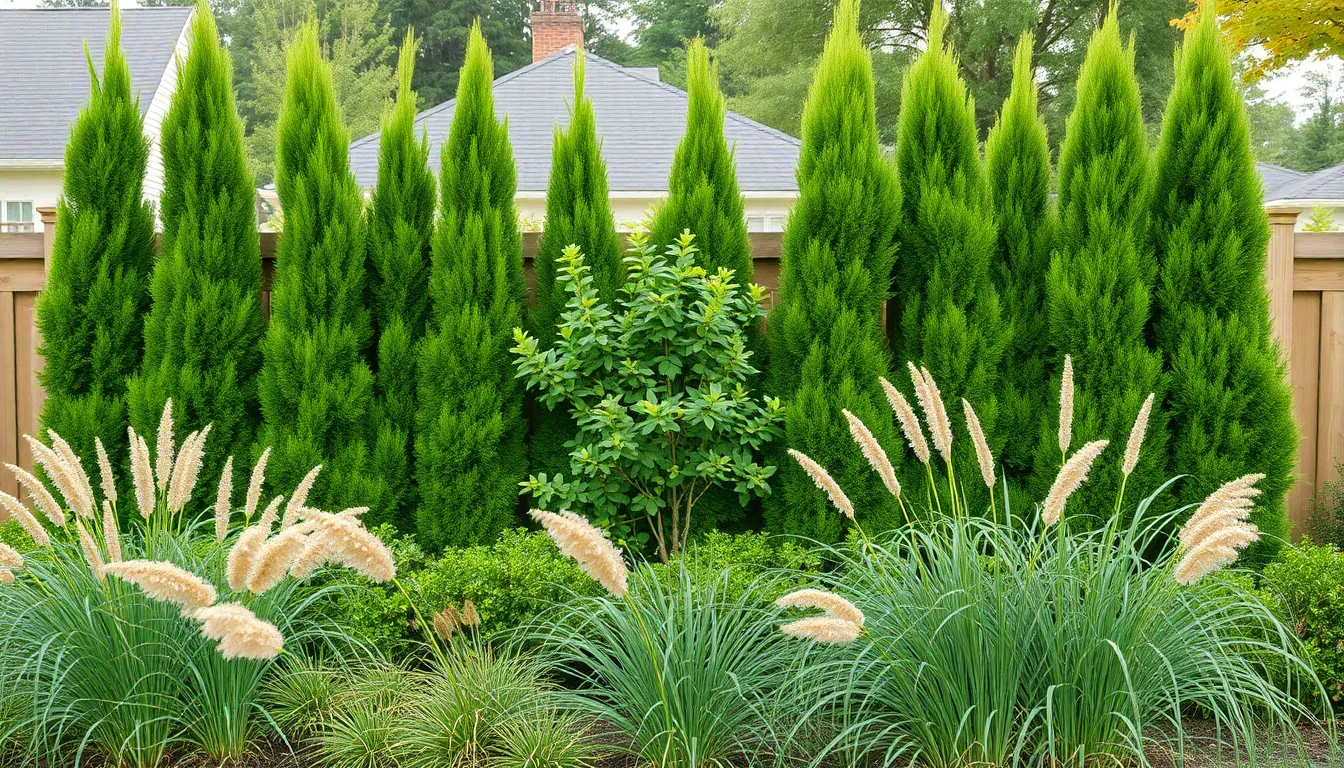
Creating an effective privacy fence with plants requires strategic planning beyond simply choosing the right species. We’ll show you how to maximize coverage and visual appeal through thoughtful design techniques.
Layering Plants for Dense Coverage
Layering different plant species creates the most effective privacy screening while eliminating gaps that single-species plantings often leave. We recommend combining evergreen trees like Green Giant Arborvitae as your main backdrop with flowering shrubs such as Skip Laurel in front for a multi-textured barrier.
Different foliage types work together to fill every sight line throughout the year. Needle-bearing evergreens like Hick’s Yew provide year-round coverage while broad-leaved plants add seasonal interest and depth. Mixed plantings also reduce disease risk since pests and pathogens typically target exact plant families.
Combining fast-growing species with slower, denser varieties ensures both immediate screening and long-term durability. Plant quick-coverage options like Leyland Cypress for instant results while establishing slower-growing but denser plants like Emerald Green Arborvitae for permanent structure.
Spacing Guidelines for Optimal Growth
Spacing plants correctly prevents overcrowding while ensuring adequate coverage as your privacy fence matures. Fast-growing trees like Green Giant Arborvitae and Leyland Cypress need 5 feet between each plant to accommodate their mature width of 10-20 feet.
Narrower species require closer spacing for optimal screening results. Emerald Green Arborvitae, which grows only 4-5 feet wide, should be planted 3 feet apart to create a tight, seamless screen along fence lines or property boundaries.
Proper spacing allows each plant to receive adequate sunlight, water, and nutrients without competing with neighbors. Overcrowded plants become stressed, making them more susceptible to disease and reducing their screening effectiveness over time.
Height Variations for Visual Interest
Incorporating plants of varying heights creates natural-looking privacy screens that avoid the flat, wall-like appearance of single-height plantings. Use taller specimens like 20-30 foot Leyland Cypress or Green Giant Arborvitae as your primary privacy barrier in the back row.
Medium-height plants like 12-15 foot Skip Laurel work perfectly as secondary screening in front of taller specimens. Lower shrubs and ornamental grasses can soften harsh fence lines while maintaining the overall privacy function.
Staggered heights also provide better wind resistance and create microclimates within your privacy fence that benefit wildlife. Birds find nesting sites at different levels while beneficial insects use varying plant heights for shelter and feeding.
Care and Maintenance for Privacy Fence Plants
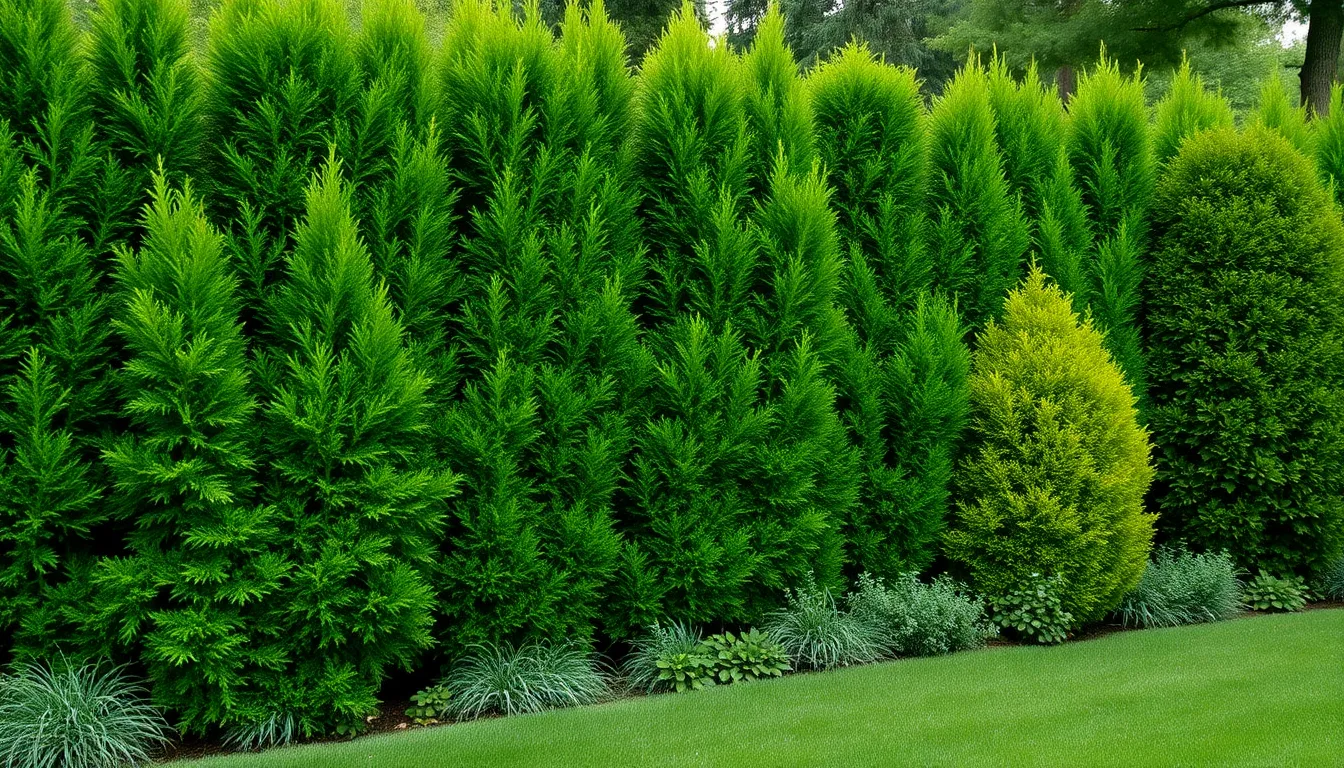
Proper care ensures your privacy plants establish strong root systems and maintain dense foliage for effective screening. Regular maintenance keeps these living barriers healthy and attractive throughout the years.
Watering Requirements by Plant Type
Evergreen varieties like Yew and Arborvitae need consistent moisture during their establishment phase and drought periods. These plants thrive with moderate watering and good drainage once their root systems develop. Overwatering can damage these species, so we recommend checking soil moisture before watering.
California Wax Myrtle prefers full sun conditions and grows rapidly with minimal water requirements. Once established, this plant performs best without irrigation since excess water causes it to flop over. We suggest allowing natural rainfall to provide most of the moisture this hardy species needs.
Broadleaf shrubs including Blue Prince and Blue Princess Holly require well-drained acidic soil with consistent but not excessive watering. These varieties tolerate partial shade conditions and adapt well to moderate moisture levels. Proper drainage prevents root rot while maintaining the healthy foliage these plants need for privacy screening.
Low-maintenance shrubs such as Boxwood, Lorapetalum, and Burford Holly adapt easily to moderate watering schedules. These species thrive in suitable soil conditions with balanced moisture levels. We find these plants forgiving if you occasionally miss watering sessions once they’re established.
Pruning Schedules for Shape Control
Annual clipping works best for Hick’s Yew and Arborvitae to maintain neat hedge shapes and dense growth patterns. These evergreens respond well to regular trimming that encourages bushy development. Timing this maintenance during late winter or early spring produces the best results for privacy screening.
California Wax Myrtle benefits from pruning to prevent flopping and maintain dense screen coverage. Shape this fast-growing plant during active growing seasons when it recovers quickly from cuts. We recommend pruning this species every six months to keep it looking tidy and functioning effectively as a privacy barrier.
Occasional pruning enhances Boxwoods and Lorapetalum by encouraging elegant appearance and bushy growth habits. These shrubs maintain their shape naturally but benefit from light trimming to remove dead branches. Strategic cuts during spring promote new growth that fills in gaps for better privacy coverage.
Fertilizing for Healthy Growth
Annual fertilization supports Yews and Arborvitae by maintaining their health and promoting dense foliage development. These evergreens benefit from balanced fertilizers applied in early spring before new growth begins. Proper nutrition helps these plants resist diseases and maintain the thick coverage essential for privacy screening.
Broadleaf evergreens like hollies perform optimally with balanced, slow-release fertilizers designed for acid-loving plants. These species require exact nutrients to maintain their glossy leaves and vigorous growth. We apply these specialized fertilizers twice yearly for consistent results and healthy development.
General-purpose shrub fertilizer works well for Boxwood and Burford Holly when applied during early spring growing seasons. These adaptable plants respond positively to standard fertilization that supports vibrant foliage and steady growth. Quality fertilizer application encourages the dense branching patterns that make these shrubs effective privacy answers.
Conclusion
Creating a natural privacy fence with plants offers us the perfect blend of functionality and beauty for our outdoor spaces. We’ve explored many options from fast-growing evergreens to flowering shrubs and ornamental grasses that can transform our properties into private sanctuaries.
The key to success lies in choosing the right plants for our exact climate conditions and maintenance preferences. Whether we opt for low-maintenance junipers or dramatic pampas grass we’re investing in a living solution that’ll continue providing value for decades.
With proper planning timing and care our plant-based privacy screens will flourish into stunning natural barriers. We’ll enjoy enhanced property value reduced noise pollution and the satisfaction of creating an eco-friendly solution that benefits both our families and local wildlife.
Frequently Asked Questions
What are the best fast-growing trees for natural privacy screening?
The top fast-growing privacy trees include Leyland Cypress (3-4 feet per year), Arborvitae varieties like Green Giant and Emerald Green, and Eastern Red Cedar. These evergreens provide year-round coverage, with Leyland Cypress reaching up to 60 feet tall. They offer dense screening with minimal maintenance and are suitable for various climate zones.
How do evergreen shrubs compare to trees for privacy barriers?
Evergreen shrubs offer more flexibility than trees while providing substantial coverage. Options like Common Privet, Golden Privet, and Boxwood can be pruned into dense hedges. Sweet Viburnum adds seasonal interest with fragrant flowers. Shrubs require less vertical space and allow for layered planting designs with mixed borders.
Can climbing vines provide effective privacy without taking up ground space?
Yes, climbing vines are excellent vertical privacy solutions that transform fences and walls into living screens. Boston Ivy offers rapid growth and stunning fall foliage, while Clematis provides colorful blooms. These vines maximize privacy coverage without consuming valuable ground space in smaller yards.
What flowering plants can provide both beauty and privacy?
Lilac bushes offer aromatic privacy with dense coverage and beautiful spring blooms. Forsythia provides early spring color and quick growth. Climbing rose varieties combine natural beauty with security through thorny stems. These flowering options create stunning living barriers that change throughout the seasons.
Are ornamental grasses effective for privacy screening?
Ornamental grasses like Pampas Grass, Fountain Grass, and Miscanthus species create effective barriers with year-round visual interest. They adapt well to various climates and light conditions, offering dramatic height and bold screening capabilities while adding graceful movement and texture to landscapes.
What are the best low-maintenance privacy plants for busy homeowners?
Juniper varieties (Blue Point, Spartan) thrive in drought conditions with minimal watering. Yew shrubs work well in shaded areas, maintaining dense foliage year-round. Holly bushes provide glossy leaves and security with low care requirements. These hardy plants deliver excellent screening with minimal maintenance.
When is the best time to plant privacy barrier plants?
Spring planting offers moderate temperatures and increased rainfall for strong root development, ideal for Emerald Green Arborvitae and Skip Laurel. Fall planting provides cooler soil temperatures that encourage root growth, perfect for Leyland Cypress. Both seasons allow plants to establish before extreme weather conditions.
How should privacy plants be spaced for optimal growth?
Proper spacing prevents overcrowding while ensuring dense coverage. Follow specific spacing guidelines for each plant type, typically allowing room for mature size. Layer different plant species at varying heights to create natural-looking screens with better wind resistance and enhanced visual interest.
What winter protection do privacy plants need?
Evergreen privacy plants benefit from mulching, burlap screens, and windbreaks during harsh winters. Apply mulch around the base, use burlap to shield from wind and snow damage, and create windbreaks for additional protection. Proper winter care ensures plants survive and thrive for decades.
How do you maintain privacy fence plants for best results?
Regular watering based on plant needs (Yew and Arborvitae need consistent moisture, while California Wax Myrtle requires minimal water), scheduled pruning to maintain shape and density, and appropriate fertilization support healthy growth. Follow specific care guidelines for each plant type to ensure effective screening.

